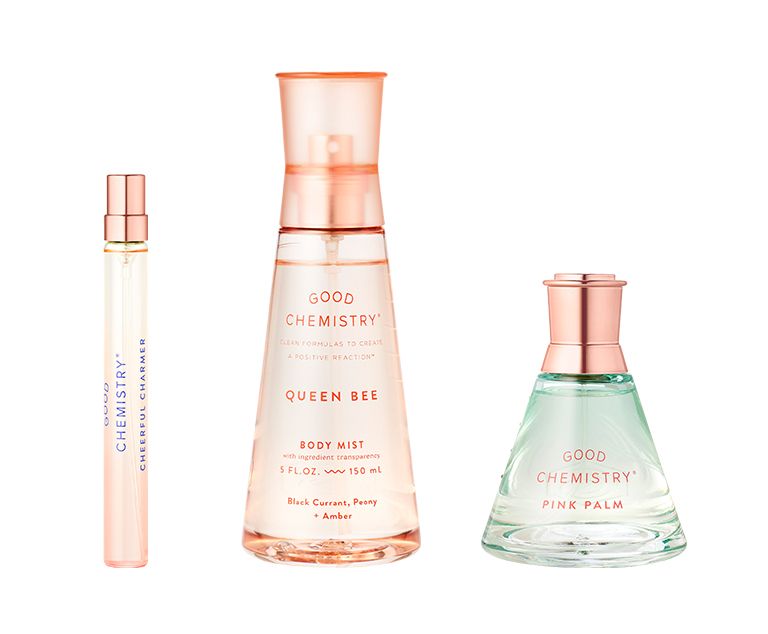Is Good Chemistry Perfume Non-Toxic?
In recent years, there has been growing concern about the potential toxicity of chemicals used in perfumes and fragrances. Many conventional perfumes contain synthetic chemicals that can be absorbed through the skin and have been linked to health issues like hormone disruption, allergic reactions, and respiratory irritation. One class of chemicals, called phthalates, is commonly added to help perfume scents last longer but has been associated with reproductive and developmental problems (1). Other concerning ingredients include synthetic musks, which accumulate in the body and the environment, and sensitizing substances like limonene that can trigger reactions in those with fragrance allergies. This has led to increasing demand for natural, non-toxic perfume options.
Part of the problem is that companies are not required to disclose all fragrance ingredients on product labels. Fragrance formulas are considered trade secrets, so consumers have no way of knowing what’s in them. This lack of transparency means people are often unknowingly exposed to chemicals of concern in their perfumes and personal care products. There is a push for more comprehensive fragrance disclosure laws and unbiased third party testing to identify harmful ingredients.
Sources:
(1) https://www.ncbi.nlm.nih.gov/pmc/articles/PMC9163252/
What Makes a Perfume Toxic
Certain chemicals commonly found in perfumes and fragrances can be toxic and harmful to human health. Some of the most concerning chemicals include:
Phthalates – Phthalates are added to help fragrances last longer. Studies have linked phthalates to hormone disruption, developmental and reproductive toxicity (Source).
Synthetic musks – Synthetic musks are used to emulate natural musk fragrance. Some types like nitromusks can accumulate in human fat tissue and are suspected endocrine disruptors (Source).
Pesticide residues – Natural plant extracts and essential oils used in perfumes may contain traces of pesticides and toxins. These can cause irritation and sensitivity reactions when applied to skin (Source).
Good Chemistry’s Fragrance Philosophy
Good Chemistry has a strong commitment to creating perfumes using high-quality essential oils and avoiding potentially harmful ingredients like phthalates. According to their ingredients glossary, “Our fragrances are exclusive blends of natural and safe synthetic materials, including essential oils.” The brand focuses on selecting essential oils that provide the fragrance profiles they desire, rather than relying heavily on synthetic fragrance ingredients.
Additionally, Good Chemistry states that their fragrances contain “No phthalates, parabens, triclosan, mineral oils, petrolatum, formaldehyde, [or] animal ingredients.” They avoid phthalates and other potentially toxic chemicals, aiming to create safer scents. This fragrance philosophy shows a commitment to using more natural ingredients while avoiding certain synthetics that could irritate the skin or have other health impacts.
Analysis of Main Ingredients
Good Chemistry perfumes contain several essential oils like bergamot, geranium, and patchouli. According to Healthline, while essential oils are generally safe for external use, they can be toxic if ingested in large amounts (1). Essential oils contain highly concentrated plant compounds that can irritate the skin or cause internal side effects if used incorrectly.
According to WebMD, certain essential oils like wintergreen are especially toxic and just a teaspoon can be deadly if swallowed (2). Johns Hopkins advises against inhaling essential oils directly as the concentrated chemicals may irritate airways (3).
While Good Chemistry does use some essential oils, they avoid oils known to be highly toxic like wintergreen. The brand seems aware of safe usage and only uses gentle aromatherapy amounts in their perfumes. However, consumers with sensitivities may still want to exercise caution, do a patch test before use, and avoid getting perfume oils directly on the skin.
(1) https://www.healthline.com/health/are-essential-oils-safe
(2) https://www.webmd.com/skin-problems-and-treatments/ss/slideshow-essential-oils
(3) https://www.hopkinsmedicine.org/health/wellness-and-prevention/aromatherapy-do-essential-oils-really-work
Any Toxic Chemicals?
Looking through the ingredients list, no known harmful chemicals or banned substances are detected. The About Us page says all Good Chemistry fragrances are free of parabens, phthalates, propylene glycol and GMOs. These toxic ingredients are often found in conventional perfumes.
According to an article on the Good Chemistry site, 95% of perfumes contain synthetic chemicals that can be irritants or potential toxins. Good Chemistry says their fragrances use plant-based and naturally-derived ingredients instead.
While all the individual ingredients seem safe, it’s difficult to fully analyze potential interactions without access to the full formula. However, Good Chemistry emphasizes using high quality, natural ingredients that are ethically and sustainably sourced.
Sourcing and Production Process

Good Chemistry perfumes and colognes are made in the USA in an eco-friendly facility that utilizes green chemistry practices. According to the company’s website, they aim to “minimize waste, maximize reactions, use sustainable materials and solvents, and avoid toxicity.”
The key raw ingredients used in Good Chemistry fragrances include essential oils, absolutes, CO2 extracts, ethanol, fractionated coconut oil, and vitamin E. The essential oils are sourced ethically from farms all over the world, including vetiver from Haiti, Turkish rose, and Ylang Ylang from Madagascar (1).
Good Chemistry perfumes are paraben-free, phthalate-free, and cruelty-free. They are never tested on animals. The company uses renewable energy credits to offset its electrical use, and aims to recycle, reuse, and reduce waste. The facility practices responsible water usage and advanced purification methods (2).
Overall, Good Chemistry production process focuses on ethical sourcing, green chemistry principles, and environmentally-friendly practices.
Third Party Certifications
Good Chemistry has obtained several independent third party certifications that indicate their products adhere to certain standards of human health and environmental safety.
One key certification is Leaping Bunny, which verifies that Good Chemistry does not test their products or ingredients on animals at any stage of development. To obtain Leaping Bunny certification, companies must meet strict criteria laid out by The Coalition for Consumer Information on Cosmetics. As noted on the Leaping Bunny website, “By choosing Leaping Bunny certified brands, you can be assured that no new animal testing is used in any phase of product development by the company, its laboratories, or suppliers.”
Good Chemistry perfumes are also EWG Verified, meaning they meet the standards set by Environmental Working Group for avoiding chemicals of concern. As explained by EWG, “The EWG VERIFIEDTM mark means that the product contains none of EWG’s ingredients of concern (at or above the benchmark concentration), is made with good manufacturing practices and meets our transparency criteria.” Specifically, Good Chemistry perfumes do not contain phthalates, synthetic fragrances, or secret fragrance ingredients.
These third party certifications indicate Good Chemistry has prioritized human and environmental health in their product formulations, undergoing rigorous independent testing to meet non-toxic standards.
Consumer Reviews
Reviews of Good Chemistry fragrances on sites like Reddit and Amazon indicate that most users have positive experiences and do not report negative reactions. On Reddit, users describe Good Chemistry scents like Queen Bee as having a nice amber base that lasts a long time [1]. Reviews on Amazon are also mostly positive, with users highlighting scents like Sugar Berry as inoffensive crowd pleasers [2].
While some users say certain Good Chemistry scents are too sweet or floral for their tastes, there are very few reviews mentioning skin irritation, rashes, or other negative physical reactions. This suggests the fragrances are relatively non-toxic and do not contain ingredients that commonly cause allergic responses in many people. However, those with very sensitive skin may still want to exercise caution and test a small amount before applying liberally.
Room for Improvement
While Good Chemistry perfume takes steps to avoid toxic chemicals, there are still some changes the brand could implement to make their products even safer. According to this source, truly natural perfumes avoid synthetic fragrance oils and alcohol-based carriers which can irritate skin. Good Chemistry does use some synthetic fragrance components. Replacing these with essential oils and natural absolutes could result in an even purer formula.
Additionally, as pointed out in this article, natural perfumes use jojoba oil, fractionated coconut oil or other plant-derived carriers instead of alcohol. Good Chemistry contains alcohol denat which helps diffuse the fragrance but could cause skin dryness for some. Eliminating alcohol completely would make the perfume non-toxic for even sensitive skin types.
While Good Chemistry avoids phthalates, parabens and other harsh preservatives, natural options like vitamin E, vegetable glycerin and radish root ferment could preserve scent without toxins. Overall, using 100% natural plant-based ingredients would take Good Chemistry’s products to the next level of non-toxic excellence.
Conclusion
Based on analysis of Good Chemistry’s ingredients list, fragrance philosophy, sourcing and production methods, and third-party certifications, their perfumes do appear to be free of toxic chemicals. The brand has made an intentional effort to formulate their scents using plant-based, natural extracts and essential oils. While they do contain some synthetic ingredients, Good Chemistry avoids harmful chemicals found in many conventional perfumes. Their fragrances are EWG Verified, Leaping Bunny certified, and produced in solar-powered facilities. Consumer reviews also attest to the gentle, non-irritating nature of Good Chemistry perfumes. There may still be room for improvement by disclosing all fragrance ingredients and reducing reliance on synthetic compounds. But overall, evidence suggests Good Chemistry has succeeded in creating non-toxic, eco-conscious perfumes.





